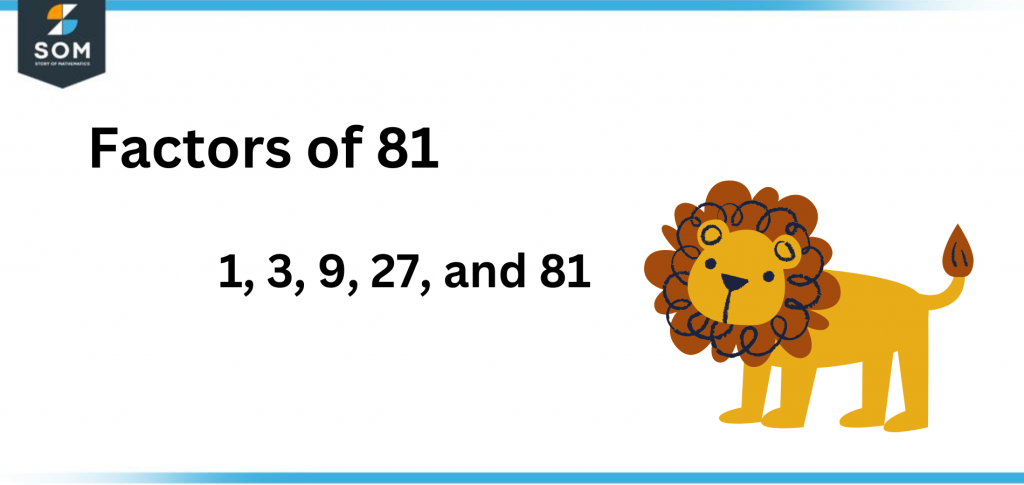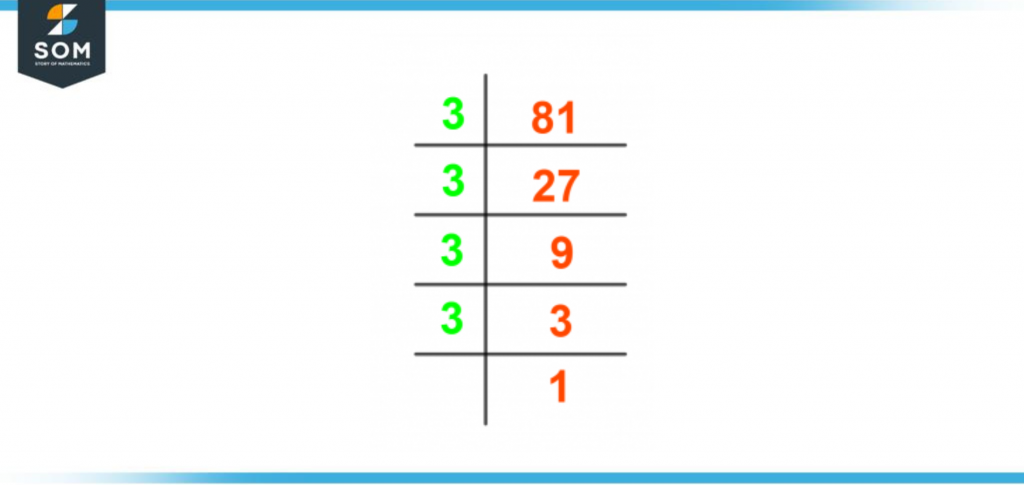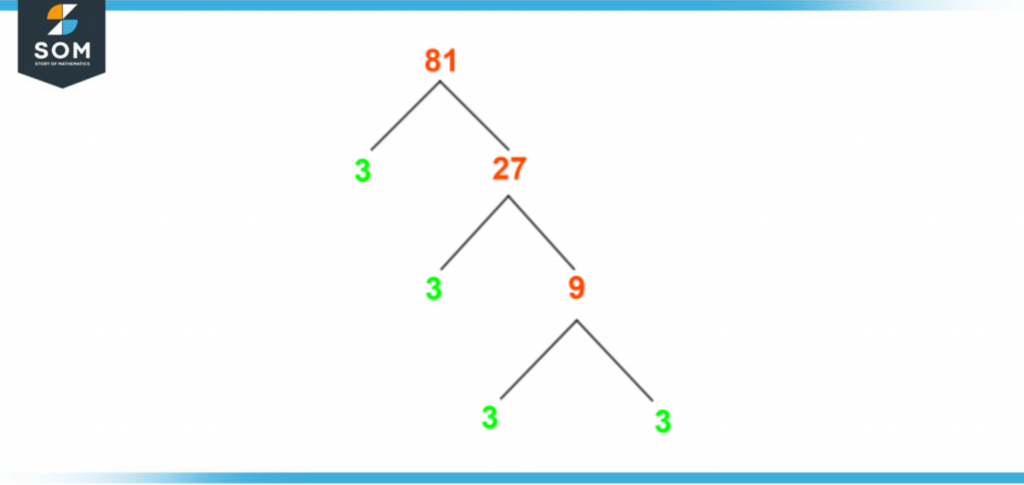JUMP TO TOPIC
Factors of 81: Prime Factorization, Methods, Tree, and Examples
Factors of 81 are defined as all the natural numbers that divide the number 81 entirely and leave no remainder behind.
Figure 1 – All possible Factors of 81
- 81 is an odd as well as a natural number.
- 81 is a composite number.
- 81 is a perfect square of the number 9.
- 81 is a deficient number. In number theory, a deficient number or defective number is a number n for which the sum of divisors of n is less than 2n.
What Are the Factors of 81?
Factors of 81 are 1, 3, 9, 27, and 81. 81 is an odd composite number. It has five factors in total that are completely divisible by 81. The factors are the number that divides the given number evenly without residue.Interesting Information
For further understanding of the factors of 81, the following information must be acknowledged.- 81 has one as its smallest factor.
- The factors of the number are never bigger than the number. This shows that 81 is the biggest factor of 81 as it never is a factor in itself.
- As 81 is an odd number, all the factors of 81 are also odd numbers.
- Another exciting fact about the number 81 is that 81 has only one prime factor (3) and three composite factors (9, 27, and 81). 1 is its factor, as 1 is the factor of every number.
- The cross sum of the number 81 is nine, which is an odd composite number.
- The Sum of divisors of 81 is an odd composite number 121.
How To Calculate the Factors of 81?
You can calculate the factors of 81 easily by using the division method. For this purpose, 81 is divided into its respective parts by the smallest natural number.Dividing 81 by the smallest natural number is 1.\[\dfrac{81}{1} = 81 , r = 0\]As 1 has completely divided the number 81 and left no remainder, 1 is a factor of 81.Now consider the next natural number in the count, the smallest even prime number (2), to divide 81 into its factors.\[\dfrac{81}{2} = 40.50 , r ≠ 0 \]Two cannot divide the number 81 completely and produces a fraction in decimal. So, 2 is not a factor of 81.To find the rest of the factors of 81, divide 81 by the following consecutive number in the compiled list and determine whether it is divisible by 81.Following are the factors:\[\dfrac{81}{3} = 27, r = 0\]\[\dfrac{81}{9} = 9, r = 0 \]\[\dfrac{81}{27} = 3, r = 0\]\[\dfrac{81}{81} = 1, r = 0\]The numbers shown are wholly divisible by 81 and do not leave any remainder. The factor list of 81 is given as follows:Factor list of 81 = 1, 3, 9, 27, and 81
Factors of 81 by Prime Factorization
To find out the factors of a given number, we can use the prime factorization method. The factorization of a given number is the representation in the form of a product over all possible prime factors.Prime factorization is particularly used to find the prime factors of the given number. Let us find out how to calculate the factors of 81 using the prime factorization technique.In order to find the factors of 81, first of all, determine the smallest number that can be divided by 81 without a remainder. The number that is produced after the division is then divided by the next number by which it is divisible, and the procedure continues till 1 is received.Follow the given steps to understand the factorization of 81 using the prime factorization method.The process can be started by dividing the smallest available prime number (3) with the given number 81.\[\dfrac{81}{3} = 27 \]The resultant number (27) obtained from this division is divided again by the smallest possible prime number, which, again, is 3.\[\dfrac{27}{3} = 9 \]Again, the quotient obtained is divisible by 3.\[\dfrac{9}{3} = 3 \]The resultant number is again divided by 3.\[\dfrac{3}{3} = 1 \]Once 1 is received as the quotient, the further division is not possible. Therefore the prime factorization of 81 can be expressed as:Prime Factorization = 3 × 3 × 3 × 3
Prime factorization of 81 can also be expressed as:81 = 3$^4$
Prime factorization of 81 is represented by the following figure 2.
Figure 2 – Prime Factorization of 81
Factor Tree of 81
A factor tree is a graphical representation of the prime factorization of 81. It illustrates how a number is divided into its factors. A factor tree can also help to determine the prime factors of the number.The idea of a factor tree can be demonstrated in the form of a tree which splits into branches containing the factors of the number. The tree continues to extend until the further division is impossible. The factor tree usually ends at prime factors.The splitting of numbers stops at the point where a certain split produces prime numbers on both of its ends.The factor tree method can be demonstrated by the division process shown below:81 = 3 × 27
If we write 27 into multiples, it would be;27 = 3 × 9
Upon dividing 9 into its multiples;9 = 3 × 3
By dividing 3 further into its multiples, it would be;3 = 3 × 1
In the end, you can observe that further division is not possible; hence prime numbers are obtained, and the procedure stops here. The factors tree of 81 is represented in figure 3.
Figure 3 – Factor Tree of 81
Factors of 81 in Pairs
Factors of 81 in pairs are said to be the set of two natural numbers which multiply to produce the number 81. In other words, it is the demonstration of the product of the factors of the number 81 in the form of pairs.1 × 81 = 81
3 × 27 = 81
9 × 9 = 81
27 × 3 = 81
81 × 1 = 81
The number 81 has only 5 factors in total which can be represented in sets of pairs as follows:(1, 81)
(3, 27)
(9, 9)
27, 3)
(81, 1)
As the product of two negative numbers always produces a positive number. So, the number 81 can have negative pair factors also.(-1) × (-81) = 81
(-3) × (-27) = 81
(-9) × (-9) = 81
(-27) × (-3) = 81
(-81) × (-1) = 81
The negative pair factors of number 81 are as follows:(-1, -81)
(-3, -27)
(-9, -9)
(-27, -3)
(-81, -1)
Important Points
- The factors of the number are classified as integers. They can be positive and negative.
- The factors of the number can never be in the form of decimals or fractions.
- The total number of factors pairs is always the same, whether it is positive or negative.
- The positive and negative factors are the same, with opposite signs.
Factors of 81 Solved Examples
Following are some solved examples.Example 1
Consider the factors of 81 in pairs and select a pair factor from the given options with the following property.- A pair factor with both factors as odd as well composite numbers.
- (1, 81)
- (3, 27)
- (9, 9)
Solution
In the given options, consider the first two sets of pairs (1, 81) and (3, 27). Although these two options fulfill the first condition of having both factors as odd numbers, these do not fulfill the condition of composite numbers.However, consider the 3rd option (9, 9). The number 9 fulfills both the conditions of being an odd number and having more than two factors (a composite number).Hence, the correct option to choose is (9, 9)Example 2
William plans to read a story from a book and decides to read 3 pages every night before going to sleep. On the 27th day, the storybook ends as William completes reading the 3 pages on the 27th day. Please help William to find out the total number of pages of the book.Solution
The total number of pages of the book can be found by the product of the total number of days William had read and the number of pages read daily.Number of days = 27
Number of pages read per day = 3
The total number of pages the book has = is 27 × 3
Total number of pages the book has = 81
Hence, the book constitutes 81 pages that William finished reading in 27 days (3 pages per day).Images/mathematical drawings are created with GeoGebra.